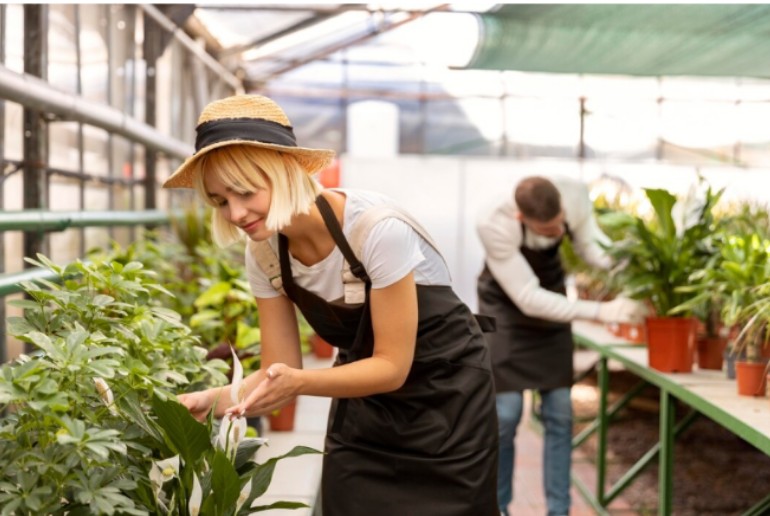Greening your living space can transform your home into a refreshing, vibrant oasis. For those new to plant care, the idea of starting a nursery might seem daunting. However, with the right guidance and enthusiasm, even novices can cultivate a thriving collection of greenery. This guide aims to provide all the essential information needed to begin your plant nursery journey, ensuring your space flourishes with life and colour.
Choosing The Right Plants
Selecting suitable plants is the first crucial step in establishing your nursery. Consider the environment of your home, including light levels, humidity, and temperature. Plants like succulents and cacti thrive in bright, arid conditions, making them ideal for sunny windowsills. Conversely, ferns and mosses prefer shaded, moist environments, perfect for less illuminated corners.
It’s also important to think about your lifestyle and how much time you can dedicate to plant care. Some species, such as pothos and spider plants, are forgiving and require minimal maintenance, making them ideal for busy individuals or those new to plant care. On the other hand, orchids and bonsai trees demand more attention and expertise, suitable for those who can commit more time to their nursery.
Essential Tools And Supplies
Creating a successful plant nursery requires more than just plants. Having the right tools and supplies will significantly enhance your gardening experience. Start with basic equipment like watering cans, pruning shears, and a good quality soil mix. These are fundamental in ensuring your plants receive adequate care and nutrition.
Investing in pots with proper drainage is also vital. Containers without drainage holes can lead to waterlogged soil, causing root rot. Additionally, consider acquiring a humidity tray, especially for tropical plants that thrive in higher moisture levels. Fertilisers tailored to your plant types will provide the necessary nutrients to support healthy growth.
A soil moisture metre can be an invaluable tool for beginners, helping to prevent over- or under-watering. Lastly, labels or markers are useful for keeping track of different plant species, especially as your collection grows.
Plant Care Basics
Understanding the fundamental aspects of plant care is essential for any budding gardener. Watering is a critical component; it’s important to water deeply but infrequently, allowing the soil to dry out between sessions. Over-watering can be just as harmful as neglect, leading to root rot and other issues.
Light is another crucial factor. While some plants need direct sunlight, others may thrive in low-light conditions. Understanding the light requirements of each species will help you position them correctly in your home. For those with limited natural light, grow lights can be an effective solution, providing the necessary spectrum for photosynthesis.
Temperature and humidity also play significant roles. Many houseplants are tropical in origin and prefer warm, humid environments. Maintaining a consistent temperature and using a humidifier can replicate these conditions. During colder months, keep plants away from draughts and heating vents to prevent stress.
Propagation Techniques
Once you have established a healthy nursery, propagation can be an exciting way to expand your collection. This process involves growing new plants from existing ones, which can be achieved through several methods, including cuttings, division, and seeds.
Taking cuttings is one of the simplest and most common techniques. For example, a stem from a pothos plant can be placed in water until roots develop, after which it can be potted in soil. Division works well for plants that grow in clumps, like snake plants. By carefully separating the root ball, you can create multiple new plants from one original.
Growing from seeds offers the rewarding experience of nurturing a plant from its earliest stages. This method requires patience and specific conditions, such as the right temperature and soil type, to ensure successful germination. Whichever method you choose, propagation allows for a cost-effective and fulfilling way to enhance your plant nursery.
Troubleshooting Common Issues
Even with the best care, plants can encounter problems. Identifying and addressing these issues promptly can save your plants from decline. Yellowing leaves often indicate over-watering or poor drainage. Ensure pots have adequate drainage holes and adjust your watering schedule accordingly.
Pest infestations can also pose a challenge. Common indoor plant pests include spider mites, aphids, and mealybugs. Regularly inspect your plants for signs of pests, such as webbing, sticky residue, or visible insects. Using insecticidal soap or neem oil can effectively control infestations without harming your plants.
Diseases such as powdery mildew or root rot can also affect plant health. Maintaining good air circulation, avoiding water on foliage, and ensuring proper drainage can prevent these issues. If a plant becomes severely diseased, it may be necessary to remove it to protect the rest of your nursery.
Conclusion
Starting a plant nursery can be a rewarding and enriching endeavour, bringing a touch of nature into your home. By selecting the right plants, equipping yourself with essential tools, understanding basic care principles, exploring propagation methods, and troubleshooting common issues, you can develop a thriving green space. Whether you have a single windowsill or a spacious conservatory, your nursery can grow into a beautiful, personal sanctuary filled with vibrant life and tranquillity. Enjoy the journey of nurturing your plants and watching them flourish, transforming your home into a verdant haven.





